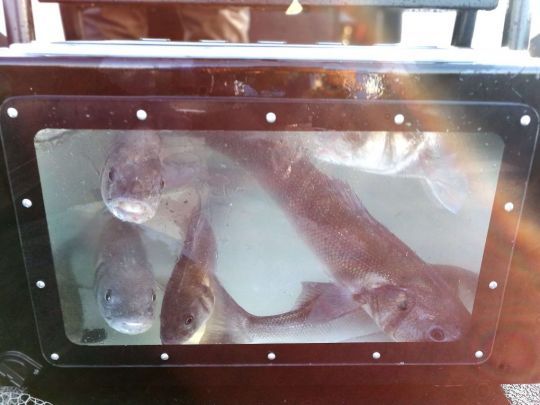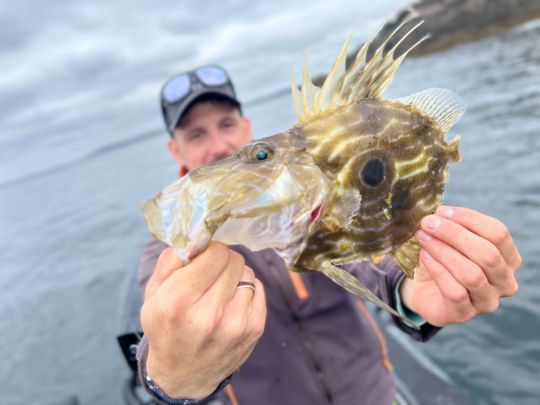A presentation that changes everything
The way a poison is presented in a photo will not have the same effect.
To illustrate this, here are two photos of the same fish. In this case, a sea bass caught on one of our latest outings.
This first photo, taken without any attention to presentation :

For the second photo, the presentation of the fish is more meticulous. Shot in portrait mode, with a little blur in the background for added emphasis.

The result is obvious: the fish in the second image stands out much more, and yet it's the same sea bass.
Take care of your fish
Taking a photo of a fish can take a little time to set up the logistics. Getting the camera out, or a tripod if you're on your own, positioning yourself in relation to the sun, and so on.
During this time, do not let the fish dry out. That goes without saying.
On the boat, I place the fish in a tank and take them out at the last moment to take a photo before releasing them.

From the shore, I place the fish in a pond while I set up the tripod and grab the remote release if I'm on my own.
Of course, especially if you want to share your photos on the Internet, avoid photographing dead fish or fish with blood on them.
Tense arms... But not too much
The quest for the trophy fish leads some anglers to over-stretch their arms to make the fish look bigger than it is.
Avoid this, as it makes photos look out of proportion and is often rightly mocked.

Put the fish in front, slightly offset from the angler's body. Look for depth by working on the blur in portrait mode. The result will be much better proportioned!

Portrait and landscape shots
There are two main choices for shooting: portrait or landscape.
When I opt for the portrait format, I prefer to hold the fish vertically, stretched out towards the lens. In this way, the fish is emphasized without taking into account the surrounding environment.

This shooting mode tends to make the fish look a little bigger than it really is, while remaining reasonable. The lack of depth makes it impossible to get a true sense of the fish's real size.
The landscape version offers more possibilities. Depending on the focus selected, you can focus on the fish and the angler, or on the angler, fish and landscape as a whole.
By using background blur, you can focus on a particular detail. I use it, for example, to highlight the lure with which I hooked a fish.

In portrait format, I like to use the wide-angle lens. This mode of shooting gives you a wide field of view which, once cropped in post-production, makes for a pretty picture.

What you need
Let me reassure you right away: you don't need to be a renowned photographer to get a nice shot of a fish. Today, most smartphones are capable of doing just that. In fact, all my photos are taken with them.
You can, of course, use an SLR camera. However, its use is perhaps more complicated, requiring a certain mastery of the art of photography. And it's not as easy to set up as a smartphone that fits in your pocket.
Useful accessories such as a tripod and remote control allow you to take photos on your own.

The case of bluefin tuna or large fish
Some fish, such as bluefin tuna, cannot be brought on board for photography. Given the size and weight of the fish, it is unthinkable to handle such a fish in the right conditions for on-board photography. You simply run the risk of killing it or even injuring yourself.
To take beautiful photos, I hold the fish along the edge with a pair of tweezers.

Firstly, it allows the fish to oxygenate after an intense fight, and we anglers then have time to position ourselves ideally for the photo shots.
Vary the shots
Fishing isn't just about the fish. Above all, it's about sharing a common passion with friends. I like to immortalize moments of conviviality on board that illustrate the atmosphere on outings.
When you're taking photos, especially if they're going to be published on social networks, be careful about the background. It would be a shame to inadvertently reveal your best secret spot because of a detail visible in the background.

The purpose of highlighting a fish is not to cheat or make it bigger than it really is. Its sole purpose is to make the photo aesthetically pleasing to the eye.

 /
/ 







